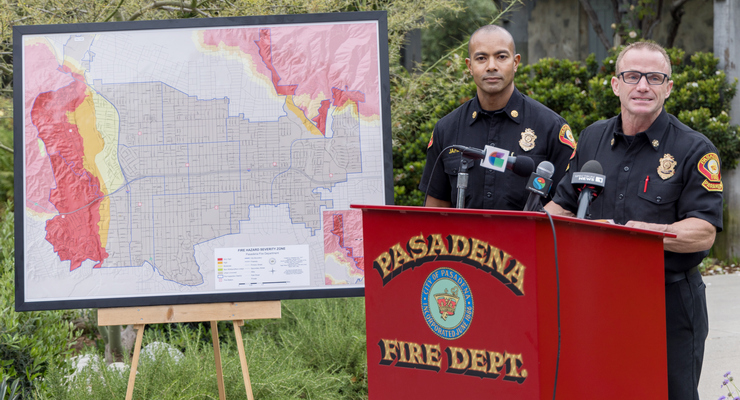Unarmed Kendrec McDade, fatally shot on March 24 by Pasadena police who say they thought he was an armed robber reaching for a gun in his pants, is the latest casualty in an increasingly volatile controversy: the rising number of unarmed black and Latino young men killed in Los Angeles County by law enforcement in so-called “waistband shootings.â€
 Kendrec McDade is shown kissing his baby brother Keion, born a week before McDade was shot to death by Pasadena police. McDade died in the same Pasadena hospital in which his brother was born. [Photo: Courtesy the McDade family, via Caree Harper]
Kendrec McDade is shown kissing his baby brother Keion, born a week before McDade was shot to death by Pasadena police. McDade died in the same Pasadena hospital in which his brother was born. [Photo: Courtesy the McDade family, via Caree Harper]
These shootings, where police wound or kill a suspect thought to be reaching for a weapon in his waistband, are what law enforcement call “state of mind” shootings where police perceive, accurately or not, that a suspect may be armed or going for a gun.
The statistic and definition are from Merrick J. Bobb of the Police Assessment Resource Center in his Sept. 11, 2011 study for the Los Angeles County Sheriff’s Dept.
In that study Merrick also said his team was “concerned to see that state of mind shootings rose by 50 percent in the past year.â€
Unlike most “waistband shootings,†in McDade’s case Pasadena police had been told by a 911 caller that the alleged robber had a gun.
That information – which turned out to be false – played a role in the thinking and actions of Officers Jeffery Newlen and Mathew Griffin as they closed in on the fleeing McDade, Pasadena Chief of Police Phillip Sanchez has said.
“There were several times that [the 911 caller] emphatically indicated that there was a gun involved in the initial incident. That’s important. It sets the platform for the mind-set of the responding officers as they pursued McDade,†Chief Sanchez said in a March 28 press conference.
Police say this was not a case of racial profiling but rather of the officers’ expectation that the suspect actually was armed which led to the shooting. Many in the community disagree.
Civil rights groups point to Bobb’s study of the Los Angeles County Sheriff’s Dept. which found that 61 percent of all state-of-mind shooting suspects were unarmed, like McDade, at the time they were shot by police.
That report also said “when there is a mistaken shooting of an unarmed individual, statistics show the suspect has a substantially higher likelihood of being a young black or Latino person than a white or Asian.â€
Pasadena police dept. spokesperson Lt. Phlunté Riddle said last week that McDade’s race – he was black – had no bearing on what happened during the encounter that led to his death.
Some activists say police are quick to act first and ask questions later if the suspect is black or Latino.
“Police-related beatings and shootings need to be investigated and monitored more closely,†El Centro de Acción Social Executive Director Randy Jurado Ertll wrote in an editorial published by the Pasadena Weekly on April 5.
“Now is the time to reform police use-of-lethal force policies,†Ertll wrote.
Martin Gordon, a leader of the Pasadena Community Coalition, said Sunday that he sees a trend “of devaluing African American men as valuable contributors to our communities and society, and buying into racial stereotypes allows the police, and others, to think they may kill (African American men in particular and people of color in general) with impunity.”
After the 2009 police shooting death of Leroy Barnes, Jr., in Northwest Pasadena, the same investigators with the Los Angeles County’s Office of Independent Review (OIR) who announced this week they will look into the McDade case submitted a report outlining policies they said should adopted by the Pasadena Police Dept.
“One of the key elements of those recommendations was more and specific training on how stops are made and the appropriate use of force,†Gordon said.
A number of local civil rights leaders say if OIR recommendations to the Pasadena police in the Barnes case had been taken seriously and implemented properly, the McDade shooting might not have occurred.
Gordon says a second follow up concern is the lack of citizen oversight of the police department’s use of force.
“Back in 2010 Chief Sanchez suspended the Citizens Review Board stating it did not comply with the Brown Act and promised that the City Attorney would come forward with a plan for community oversight,” Gordon said. “It is 2012, we have another shooting and no community oversight.”
NAACP Pasadena Branch president Joe Brown points to what he says are the Police Department’s failures to comply with policies, procedures and guidelines, and says citizens should be concerned.
At McDade’s remembrance service on April 7, Brown told the mourners “both the Pasadena NAACP and the State NAACP are prepared to do battle†with the police for those alleged failures.
“Let me say it this way,†Brown said. “There will be a ‘Rumble in the Jungle.’â€














 0 comments
0 comments


